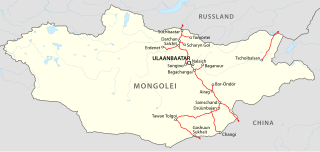
The Trans-Mongolian Railway links Ulan-Ude on the Trans-Siberian Railway in Buryatia, Russia, with Jining in Inner Mongolia, China, via Ulaanbaatar, the capital of Mongolia. It was completed in 1956 and runs from northwest to southeast, with major stations at Naushki/Sükhbaatar on the Russian border, Darkhan, Ulaanbaatar, Choir, Sainshand, and Zamyn-Üüd/Erenhot on the Chinese border. There are important branch lines to Erdenet and Baganuur.
Khanbogd is a sum (district) of Ömnögovi Province in southern Mongolia. Khanbogd is the site of the Oyu Tolgoi mine, which is 40 kilometres (25 mi) from the sum centre. In 2009, its population was 3,154.
Tsogttsetsii is a sum (district) of Ömnögovi Province in southern Mongolia. The Tavan Tolgoi coal mine is 15 km southwest of the sum center. In 2009, its population was 2,642.

Tavan Tolgoi is one of the world's largest untapped coking and thermal coal deposits, located in the Ömnögovi Province in southern Mongolia. It has a total estimated resource of 6.4 billion tonnes, one quarter of which is high quality coking coal. It is divided into six sections: Tsankhi, Ukhaa Khudag, Bor tolgoi, Borteeg, and Southwest and Eastern coalfields. The Tsankhi section is the largest part, and is divided into East and West Tsankhi - these have had the most focus recently.

The Oyu Tolgoi mine, also Oyuutolgoi, is a combined open pit and underground mining project in Khanbogd sum within the south Gobi Desert, approximately 235 kilometres (146 mi) east of the Ömnögovi Province capital Dalanzadgad. The site was discovered in 2001 and is being developed as a joint venture between Turquoise Hill Resources with 66% ownership and the Government of Mongolia with 34%. The mine began construction as of 2010 and shipped its first batch of copper on 9 July 2013.
Khajuu-Ulaan is urban-type settlement in Ikhkhet sum (district) of Dornogovi Province in south-eastern Mongolia. Khajuu-Ulaan is located 53 km SE from Darkhan sum center and 43 km NE of Bor-Öndör city of Khentii Province, 26 km NW from the Ikhkhet sum center and 79 km NE from Airag sum center of Dornogovi Province.

Rail transport is an important means of travel in the landlocked country of Mongolia, which has relatively few paved roads. According to official statistics, rail transport carried 93% of Mongolian freight and 43% of passenger turnover in 2007. The Mongolian rail system employs 12,500 people. The national operator is UBTZ, traditionally also known as Mongolian Railway. This can be a source of confusion, since MTZ is a distinct company established in 2008. The Mongolian Railway College is located in Ulaanbaatar.
Turquoise Hill Resources was a Canadian mineral exploration and development company headquartered in Montreal, Quebec, and a majority-owned subsidiary of Rio Tinto Group. The company was called Ivanhoe Mines until August 2, 2012 when a financing agreement was completed with Rio Tinto. Rio Tinto acquired full ownership of Turquoise Hill in December 2022.

Hugo T. Dummett (1940–2002) was a South African mineral-exploration geologist who is best known for his role in the discovery of the Ekati Diamond Mine in the Barren Lands of Canada's Northwest Territories. Dummett has been described as "the brains, the ideas and the energy" behind the discovery of Ekati, which led to the creation of a new Canadian diamond-mining industry.

Khanbumbat Airport, also Oyu Tolgoi Airport, is an airport in Khanbogd, Ömnögovi, Mongolia. The airport's construction was funded by the adjacent Oyu Tolgoi mine. It is the second airport in passenger traffic in Mongolia after Buyant-Ukhaa International Airport. The airport serves nearly 100,000 passengers annually.

Tavan Tolgoi Airport is an airport serving the Tavan Tolgoi mine in Tsogttsetsii, Ömnögovi, Mongolia. It was built in 2009 by Energy Resources LLC.

Mining is important to the national economy of Mongolia. Mongolia is one of the 29 resource-rich developing countries identified by the International Monetary Fund and exploration of copper and coal deposits are generating substantial additional revenue. Coal, copper, and gold are the principal reserves mined in Mongolia. Several gold mines are located about 110 kilometres (68 mi) north of Ulaanbaatar, such as Boroo Gold Mine and Gatsuurt Gold Mine. Khotgor Coal Mine is an open-pit coal mining site about 120 kilometres (75 mi) west of Ulaangom. Ömnögovi Province in the south of Mongolia is home to large scale mining projects such as the Tavan Tolgoi coal mine and the Oyu Tolgoi copper mine. Oyu Tolgoi mine is reported to have the potential to boost the national economy by a third but is subject to dispute over how the profits should be shared. The International Monetary Fund (IMF) has estimated that 71 percent of the income from the mine would go to Mongolia.
The Windfall tax or windfall profits tax in Mongolia was a taxation on the profits made by mining companies operating in Mongolia. It was implemented in 2006 and was the highest windfall profits tax in the world. It was a tax on unsmelted copper and gold concentrate that was produced in Mongolia. The tax was repealed in 2009 and phased out over two years. Repealing the 68% tax law was considered essential to enable foreign mining companies to invest in mineral resources development of Mongolia.
Copper mining in Mongolia is a major industry and source of income for the country. There are only two companies that produce copper concentrate, Erdenet Mining Corporation, a Mongolian-Russian joint venture, and the Oyu Tolgoi mine, a joint venture between Rio Tinto Group, Turquoise Hill Resources, and the Government of Mongolia. Until 2010 copper was Mongolia's largest export.
The Ulaan Ovoo Coal Mine is a coal mine located in the Tüshig sum of Selenge aimag in northern Mongolia. It is located on the northern shore of the Zelter River a short distance west of the sum center.
The Övdög Khudag Coal Mine is a coal mine being developed in the Bayanjargalan sum of the Dundgovi in southern central Mongolia. The deposit has coal reserves amounting to projected 89 million tonnes of Lignite. Together with the "Ikh ulaan uul" deposit nearby it comprises the "Black Hills" development.
The Ulaan mine is one of the largest lead and zinc mines in Mongolia. The mine is located in southern Mongolia. The mine has reserves amounting to 38.8 million tonnes of ore grading 1.09% lead and 1.9% zinc thus resulting 0.42 million tonnes of lead and 0.74 million tonnes of zinc. The mine also has reserves amounting to 256,000 oz.
The Ulaan-Uul mine is an underground mine located in the Nogoonnuur sum of Khovd aimag in western Mongolia.

The China–Mongolia border is the international border between China and Mongolia. It runs from west to east between the two tripoints with Russia for 4,630 km (2,880 mi), with most of the boundary area lying in the Gobi Desert. It is the world's fourth longest international border.








